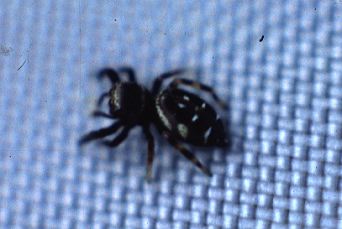 Jennifer
Reaney and Douglas
G. Pfeiffer
Jennifer
Reaney and Douglas
G. Pfeiffer Jennifer
Reaney and Douglas
G. Pfeiffer
Jennifer
Reaney and Douglas
G. Pfeiffer
(1b) 2a. With a cribellum (a transverse mate) in front of the
spinnerets,
and a calamistrum (row of bristles) on metatarsus IV, varying from just
a few bristles to a row the entire length of the
metatarsus..........Section
CRIBELLATAE 3
(1b) 2b. Without a cribellum and calamistrum..........Section
ECRIBELLATAE
4
(2a) 3a. Tarsi with a dorsal row of trichobothria (long, five
setae).
Eight eyes all light in color..........Family AMAUROBIIDAE
(2a) 3b. Tarsi either without trichobothria, or at most with one. Eight
eyes either all dark, or eyes heterogeneous, the anterior medians alone
dark; or with only six eyes, the anterior medians
lacking..........Family
DICTYNIDAE
(2b) 4a. With two, four, or six eyes..........5
(2b) 4b. With eight eyes..........6
(4a) 5a. Tracheal spiracle (or spiracles) opening just behind the
epigastric
furrow..........Family SEGESTRIIDAE
(4a) 5b. Tracheal spiracle opening either just in front of spinnerets,
or at about the middle of the venter..........Family AGELENIDAE
(4b) 6a. Tarsi with two claws, with or without claw tufts..........7
(4b) 6b. Tarsi with three claws, never with tufts, though spurious
claws may be present..........12
(6a) 7a. Eyes in three or four rows..........Family SALTICIDAE
(6a) 7b. Eyes in the more common arrangement of two rows..........8
(7b) 8a. Tracheal spiracle in advance of the spinnerets at least
one-third
of the distance between the latter and epigastric
furrow..........Family
ANYPHAENIDAE
(7b) 8b. Tracheal spiracle in the usual place just in front of the
spinnerets..........9
(8b) 9a. At least legs I and II laterigrade, i.e., turned so that
the
morphologically dorsal surface is posterior and the prolateral surface
appears to be the dorsal..........10
(8b) 9b. All legs of the usual prograde type..........11
(9a) 10a. Colulus present (a small appendage resembling a tiny
spinneret,
located immediately anterior to spinnerets). Hair over body simple and
erect. Legs I and II much longer and stouter than III and IV. Claw
rufts
lacking, or composed of simple hairs, and tarsi I and II not scopulate.
Promargin of cheliceral fang furrow unarmed..........Family THOMISIDAE
(9a) 10b. Colulus absent. Hair over body feathery or scaly, and prone.
All legs about the same length or leg II alone much longer. Claw tufts
composed of spatulate hairs and tarsi I and II scopulate. Promargin
with
one or two teeth..........Family PHILODROMIDAE
(9b) 11a. Anterior spinnerets conical, contiguous or almost so, and
not more heavily sclerotized than the posterior. Eyes homogeneous or
almost
so (with few exceptions). Endites (mouthparts ventral to mouth opening,
opposing chelicerae) without a transverse or oblique depression (except
in Micaria)...........Family CLUBIONIDAE
(9b) 11b. Anterior spinnerets cylindrical, longer and more heavily
sclerotized than the posterior, and separated by a distance about equal
to the diameter of one. Eyes distinctly heterogeneous, the anterior
medians
alone dark; the posterior medians often oblique, oval or triangular.
Endites
with an oblique depression (a) on the ventral face..........Family
GNAPHOSIDAE
(6b) 12a. Eye group hexagonal, the posterior row procurved, the
anterior
row recurved, with the clypeus high. (Abdomen pointed behind and legs
with
very prominent spines..........Family OXYOPIDAE
(6b) 12b. Eye group not forming a hexagon, and clypeus much
lower..........13
(12b) 13a. With tarsus IV in most specimens provided for at least
one-sixth
its length from the distal end with a ventral row of 6 to 10 serrated
bristles,
forming a comb, which may be poorly developed in males. Spiders hanging
in an inverted position in irregular mesh webs..........Family
THERIDIIDAE
(12b) 13b. Tarsus IV without such a comb..........14
(13b) 14a. Tarsi with trichobothria . Labium withuot thickened front
margin..........15
(13b) 14b. Tarsi without trichobothria. Labium with a thickened font
margin..........16
(14a) 15a. Posterior row of eyes so strongly recurved that it may be
considered to form two rows. Median claw smooth or with a single tooth.
Anterior piece of lorum rounded behind a fitting into a notch of the
posterior
piece. Egg sac carried attached to spinnerets and young carried on
mother's
back..........Family LYCOSIDAE
(14a) 15b. Posterior row of eyes not forming two distinct rows, but
only slightly recurved. Median claw with two or three teeth. Egg sac
held
under cephalothorax; young not carried about by mother..........Family
PISAURIDAE
(14b) 16a. Clypeus in most lower than height of the median ocular
area.
Eyes homogeneous. Chelicera with a boss (a smooth prominence at base of
lateral angle of chelicera), though rudimentary in some. (For the most
part weavers of orb webs)..........17
(14b) 16b. Clypeus usually as high as, or more commonly higher than,
height of the median ocular area. Eyes heterogeneous. Chelicerae
without
a boss. The majority do not weave orb webs..........18
(16a) 17a. Epigastric furrow between lung slits procurved.
Rudimentary
boss on chelicerae. In most specimens the chelicerae are large and
powerful.
Femora with trichobothria ..........Family TETRAGNATHIDAE
(16a) 17b. Epigastric furrow nearly straight. Boss conspicuously
present
on chelicerae in most, though rudimentary in some. Femora without
trichobothria,
or if present then femur IV provided with a double fringe of hairs on
the
prolateral surface..........Family ARANEIDAE
(16b) 18a. Tibia of male pedipalp without apophyses (a thick
process)
(though the tibia may be dilated distally). Palp of female in most
species
with a claw at the end of the tarsus. Tibia IV in most species with two
dorsal spines, or if only one spine is present then there is one short
spine on metatarsi I and II..........Family LINYPHIIDAE
(16b) 18b. Tibia of male pedipalp in most species with at least one
apophysis. Palp of female without a claw at end of tarsus. Tibia IV
with
a single dorsal spine or bristle, and with the metatarsi spineless, or
all spines lacking altogether..........Family MICRYPHANTIDAE